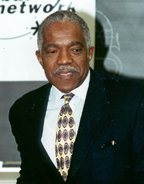Chemist James Tyson Tildon was born August 7, 1931 in Baltimore, Maryland. As a young boy he had an innate curiosity for how things work, often taking apart toys, toasters, etc., and reassembling them. When Tildon was in elementary school, his parents bought him a chemistry set, which encouraged his interest in the subject. In elementary and junior high school his teachers gave Tildon extra attention because they saw his enthusiasm for science.
While still in high school Tildon attended Maryland Academy of Science lectures at the Baltimore Public Library, which played a large role in his early scientific learning. After graduating from high school at the top of his class in 1950, Tildon attended Fisk University in Nashville, Tennessee on a scholarship. Though he did well at Fisk, he transferred to Morgan State University in Baltimore to save money by living at home. He graduated from Morgan State in 1954 with a degree in chemistry and took some time off from school to work before going to graduate school. He found work as a lab technician in the Mt. Sinai Hospital in Baltimore. He was under the supervision of Dr. Harry Gordon, who saw Tildon’s scientific abilities and encouraged him to do his own projects. He then started to work on research in vitamin E deficiencies. Unfortunately, an older technician stole his work and published it.
Tildon married Sania Amr in 1957, and the two had a child. Two years later in 1959, Tildon was nominated by Dr. Gordon for the Fulbright Scholarship to study abroad in Paris. Tildon did his research at the Institute for Biology and Physical Chemistry at the University of Paris. There Tildon and colleagues were able to isolate an enzyme that breaks down phosphorus in bacteria.
Tildon returned to Baltimore in 1960 and enrolled in a graduate program at Johns Hopkins University. As his graduate project, he researched how to isolate the chemical reaction in human cells. From this work, he was able to isolate a protein from human blood. Graduating with his doctorate in chemistry in 1965, Tildon was awarded the Helen Hay Whitney Foundation Fellowship. This lead him to Brandeis University in Waltham, Massachusetts. There, he and Dr. Nathan Kaplan isolated the process of cell division, and how adding chemicals sped up or slowed down the process.
In 1968, Tildon accepted a teaching position at the University of Maryland Baltimore in the medicine department. He taught biochemistry, as well as lab technique classes and began his own research on which chemicals can provide energy to the animal body. He found that ketones and glutamine are sources of energy aside from basic glucose. In 1975, the university sent him to study Sudden Infant Death Syndrome (SIDS) in Holland, at the University of Groningen. He was able to link one cause of SIDS to his first research project, vitamin E deficiencies.
Aside from science, Tildon also strove to improve race relations between blacks and whites. In 1972, he published a book called The Anglo-Saxon Agony that related black history to European culture. He also strove for racial equality at his university, calling for fair promotions of students regardless of their race.

